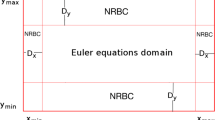Abstract
The study of acoustic receptivity in quiet disturbance environments can be decomposed into several sub-problems. One such problem consists of determining the response of the unsteady boundary layer to acoustic forcing in the freestream. In this paper, we describe two methods to characterize the acoustic boundary layer response based on the linear stability equations. In their inviscid form, we first show how to determine the reflection coefficient. The sum of the incident and reflected waves then drives the unsteady Stokes motion within the boundary layer, for which a double-layer high Strouhal number asymptotic solution is obtained. The outer layer solution is calculated numerically whereas the inner layer solution, introduced to satisfy the no-slip condition, is determined analytically. The full linear stability equations can also be integrated numerically to directly obtain a complete disturbance profile accounting for the effects of viscosity. A comparison between these models and the linearised unsteady boundary layer equation (LUBLE) model shows good agreement at high Strouhal number, low Mach number and for downstream-travelling waves. However, for near sonic Mach numbers and for upstream-travelling waves, the LUBLE are shown to be not valid because the assumption that the acoustic wavelength is long compared to the boundary layer thickness no longer holds.
Access this chapter
Tax calculation will be finalised at checkout
Purchases are for personal use only
Similar content being viewed by others
References
Asfar, O.R., Masad, J.A., Nayfeh, A.H.: A method for calculating the stability of boundary layers. Comput. Fluids 18(3), 305–315 (1990)
Balakumar, P., King, R.A., Chou, A., Owens, L.R., Kegerise, M.A.: Receptivity and forced response to acoustic disturbances in high-speed boundary layers. In: 46th AIAA Fluid Dynamics Conference. AIAA Paper 2016-3193 (2016)
Bernots, T.: Receptivity of the boundary layer in transonic flow past an aircraft wing. PhD thesis, Imperial College London (2014)
Brand, R.S., Nagel, R.T.: Reflection of sound by a boundary layer. J. Sound Vib. 85(1), 31–38 (1982)
Choudhari, M.: Acoustic receptivity of compressible boundary layers: receptivity by way of surface-temperature variations. Technical Report NASA-CR-4599, NASA (1994)
De Tullio, N., Ruban, A.I.: A numerical evaluation of the asymptotic theory of receptivity for subsonic compressible boundary layers. J. Fluid Mech. 771, 520–546 (2015)
Duck, P.W.: The response of a laminar boundary layer in supersonic flow to small-amplitude progressive waves. J. Fluid Mech. 219, 423–448 (1990)
Gaponov, S.A.: Interaction between a supersonic boundary layer and acoustic disturbances. Fluid Dynamics 12(6), 858–862 (1977)
Lees, L., Lin, C.C.: Investigation of the stability of the laminar boundary layer. Technical Report TN-1115, NACA (1946)
Mack, L.M.: Boundary layer linear stability theory. In: Special Course on Stability and Transition of Laminar Flow, number 709, pp. 3.1–3.81. AGARD Rep. 709 (1984)
Raposo, H., Mughal, S., Ashworth, R.: An adjoint compressible linearised Navier-Stokes approach to model generation of Tollmien-Schlichting waves by sound. J. Fluid Mech. 877, 105–129 (2019)
Ruban, A.I.: On Tollmien-Schlichting wave generation by sound. In Kozlov, V.V. (Ed.) Laminar-Turbulent Transition, pp. 313–320. Springer, Berlin, Heidelberg (1985)
Scott, M.R., Watts, H.A.: Computational solution of linear two-point boundary value problems via orthonormalization. SIAM J. Numer. Anal. 14(1), 40–70 (1977)
Acknowledgements
This project has received funding from the European Union’s Horizon 2020 research and innovation programme under the Marie Sklodowska-Curie grant agreement no.675008.
Author information
Authors and Affiliations
Corresponding author
Editor information
Editors and Affiliations
Rights and permissions
Copyright information
© 2022 The Author(s), under exclusive license to Springer Nature Switzerland AG
About this paper
Cite this paper
Raposo, H., Mughal, S., Ashworth, R. (2022). On the Effects of Sound in Subsonic Boundary Layer Flows. In: Sherwin, S., Schmid, P., Wu, X. (eds) IUTAM Laminar-Turbulent Transition. IUTAM Bookseries, vol 38. Springer, Cham. https://doi.org/10.1007/978-3-030-67902-6_67
Download citation
DOI: https://doi.org/10.1007/978-3-030-67902-6_67
Published:
Publisher Name: Springer, Cham
Print ISBN: 978-3-030-67901-9
Online ISBN: 978-3-030-67902-6
eBook Packages: EngineeringEngineering (R0)




